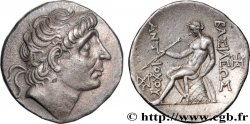上一页 1/1
fme_1054745 - IRAN - MOHAMMAD RIZA PAHLAVI SHAH Médaille, Jubilé d'or du règne Pahlavi
100.00 €约 837.00 CNY
数量
加入购物车

种类 Médaille, Jubilé d'or du règne Pahlavi
日期: 1976
铸币厂名称/城市 Iran
材质 bronze
直径 62,5 mm
模子方针 12 h.
硬币制模工 REVOL Guy-Charles (1912-1991)
重量 109,90 g.
侧面 lisse + triangle BRONZE
印模 Triangle BRONZE
关于品相的说明
Patine hétérogène. Présence de traces d’oxydation, de rayures et de légers coups notamment sur l’avers
正面
正面的文字 (LÉGENDE EN PERSE).
正面的说明书 Bustes, de profil à gauche, de Reza Chah Pahlavi et de Mohammad Reza Pahlavi. Signé : REVOL 76.
背面
背面的文字 (LÉGENDE EN PERSE).
背面的说明书 Couronne Pahlavi entourée de 50 Cercles (Commémorant la cinquantième année du règne de Pahlavi).
评论
La dynastie Pahlavi a régné sur l’Iran de 1925 à 1979. Fondée par Reza Shah Pahlavi, un ancien officier militaire, cette monarchie a remplacé la dynastie Qajar dans un contexte de modernisation et de centralisation du pouvoir. Reza Chah entreprend de vastes réformes : développement des infrastructures, création d’un État laïc, réforme de l'éducation et limitation du pouvoir religieux.
En 1941, sous la pression des Alliés pendant la Seconde Guerre mondiale, Reza Shah abdique en faveur de son fils, Mohammad Reza Pahlavi. Ce dernier poursuit la modernisation du pays, notamment à travers la Révolution blanche lancée en 1963, visant à réformer l’agriculture, accorder plus de droits aux femmes et promouvoir l'industrialisation. Toutefois, son régime autoritaire, soutenu par la police secrète (la SAVAK) et les puissances occidentales, suscite de plus en plus de mécontentement.
Ce mécontentement culmine avec la Révolution iranienne de 1979, qui met fin à la monarchie et établit la République islamique sous la direction de l’ayatollah Khomeini. Ainsi s’achève le règne des Pahlavi, marqué par des tensions entre modernisation et autoritarisme, tradition et réforme.
The Pahlavi dynasty ruled Iran from 1925 to 1979. Founded by Reza Shah Pahlavi, a former military officer, this monarchy replaced the Qajar dynasty in a context of modernization and centralization of power.. Reza Shah undertook extensive reforms: infrastructure development, creation of a secular state, educational reform and limitation of religious power..
In 1941, under pressure from the Allies during World War II, Reza Shah abdicated in favor of his son, Mohammad Reza Pahlavi.. The latter continued the modernization of the country, notably through the White Revolution launched in 1963, aimed at reforming agriculture, granting more rights to women and promoting industrialization.. However, his authoritarian regime, supported by the secret police (SAVAK) and Western powers, is causing increasing discontent..
This discontent culminated in the Iranian Revolution of 1979, which ended the monarchy and established the Islamic Republic under the leadership of Ayatollah Khomeini.. Thus ended the reign of the Pahlavi, marked by tensions between modernization and authoritarianism, tradition and reform.
En 1941, sous la pression des Alliés pendant la Seconde Guerre mondiale, Reza Shah abdique en faveur de son fils, Mohammad Reza Pahlavi. Ce dernier poursuit la modernisation du pays, notamment à travers la Révolution blanche lancée en 1963, visant à réformer l’agriculture, accorder plus de droits aux femmes et promouvoir l'industrialisation. Toutefois, son régime autoritaire, soutenu par la police secrète (la SAVAK) et les puissances occidentales, suscite de plus en plus de mécontentement.
Ce mécontentement culmine avec la Révolution iranienne de 1979, qui met fin à la monarchie et établit la République islamique sous la direction de l’ayatollah Khomeini. Ainsi s’achève le règne des Pahlavi, marqué par des tensions entre modernisation et autoritarisme, tradition et réforme.
The Pahlavi dynasty ruled Iran from 1925 to 1979. Founded by Reza Shah Pahlavi, a former military officer, this monarchy replaced the Qajar dynasty in a context of modernization and centralization of power.. Reza Shah undertook extensive reforms: infrastructure development, creation of a secular state, educational reform and limitation of religious power..
In 1941, under pressure from the Allies during World War II, Reza Shah abdicated in favor of his son, Mohammad Reza Pahlavi.. The latter continued the modernization of the country, notably through the White Revolution launched in 1963, aimed at reforming agriculture, granting more rights to women and promoting industrialization.. However, his authoritarian regime, supported by the secret police (SAVAK) and Western powers, is causing increasing discontent..
This discontent culminated in the Iranian Revolution of 1979, which ended the monarchy and established the Islamic Republic under the leadership of Ayatollah Khomeini.. Thus ended the reign of the Pahlavi, marked by tensions between modernization and authoritarianism, tradition and reform.








 对产品描述纠错
对产品描述纠错 打印
打印 分享我的选择
分享我的选择 提问
提问 Consign / sell
Consign / sell
 产品介绍
产品介绍








